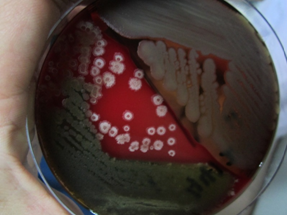I got it - Bacillus
Subtilis!!
The time I got to know it because my friends invite me to go
for a Japanese food dinner and introduce the Natto bean to me, a sticky
and ammonia-odor smell, which date back few years ago. From the
experience of natto , I know that this bacillus subtilis are simply
awesome. People manipulate it on probiotic food, aquaculture,
agriculture, household and septic system.
General application
Bacillus subtilis
are attractive industrial organisms for a variety of reasons, including
their high growth rates leading to short fermentation cycle times,
their capacity to secrete proteins into the extracellular medium, and
the GRAS (generally regarded as safe) status with the Food and Drug
Administration. The application of bacillus fermentation in food,
biopharmaceuticals, enzyme industry, agriculture, aquaculture has been
widely recognized and commercialized. For instances,
In addition to its role as model organism, Bacillus Subtilis is used in
- Commercial production of Natto Bean
- Soil Inoculant for agricultural farming
- Biological control agent.
- As an immunostimulatory agent, probiotic to aid treatment of gastrointestinal and urinary tract diseases.
- It can convert some explosives into harmless compounds of nitrogen, carbon dioxide, and water.
- Production of biosurfactant which having antibacterial effect apply in medical tools.
- Production of various enzymes protein, such as amylase, hyaluronic acid.
Nowadays,
in prospect of biochemistry, physiology, and genetics of B. subtilis,
more and further development and exploitation are in advanced growth.
The complete genome for B. subtilis 168 was recently published. With
this great achievement in applied and industry microbiology, enable the
scientist to produce new beneficial genetic-engineered products.
If
u want to know more how this microbes functioning,
please do google for that, I am you will be amazed by their works.
There
are thousands of journals characterizing this microbe of interest, and
it is impossible for me to introduce them in detailed way. Hence, I try
to make a brief introduction of this particular microbe.
History ( From Wikipedia)
In 1835, the bacterium was originally named Vibrio subtilis by Christian Gottfried Ehrenberg, and renamed Bacillus subtilis by Ferdinand Cohn in 1872. Cultures of B. subtilis
were used throughout the 1950s as an alternative medicine due to the
immunostimulatory effects of its cell matter, which upon digestion has
been found to significantly stimulate broad spectrum immune activity
including activation of specific antibody IgM, IgG and IgA secretion and release of CpG dinucleotides inducing INF A/Y producing activity of leukocytes and cytokines important in the development of cytotoxicity towards tumor cells.
It
was marketed throughout America and Europe from 1946 as an
immunostimulatory aid in the treatment of gut and urinary tract diseases
such as Rotavirus and Shigella,
but declined in popularity after the introduction of cheap consumer
antibiotics, despite causing less chance of allergic reaction and
significantly lower toxicity to normal gut flora.
Morphologic and biochemistry
They
are Gram-positive, catalase-positive bacterium, rod-shaped, and has the
ability to form a tough, protective endospore, allowing the organism to
tolerate extreme environmental conditions.
Reproduction
B. subtilis
can divide from a single cell to make two daughter cells, within 30 min
with favorable condition. Amazing right!! In addition, it forms single
endospore that can remain viable for decades and is resistant to
unfavourable environmental conditions such as drought, salinity, extreme
pH, radiation and solvents. The endospore is formed at times of
nutritional stress, allowing the organism to persist in the environment
until conditions become favorable. Most of the commercial product,
agriculture and aquaculture grade are in spore-form condition, which
mean they are simply in sleeping mode, covering them with a protective
layer. Because of this characteristic of resistance and stability,
people are happy to commercialize it into product, where they can keep
it for long period.
Prior
to the process of sporulation the cells might become motile by
producing flagella, take up DNA from the environment, or produce
antibiotics. These responses are viewed as attempts to seek out
nutrients by seeking a more favourable environment, enabling the cell to
make use of new beneficial genetic material or simply by killing of
competition. Wild-type natural isolates of B. subtilis are
difficult to work with compared to laboratory strains that have
undergone domestication processes of mutagenesis and selection. These
strains often have improved capabilities of transformation (uptake and
integration of environmental DNA), growth, and loss of abilities needed
"in the wild." And, while dozens of different strains fitting this
description exist, the strain designated 168 is the most widely used.





No comments:
Post a Comment